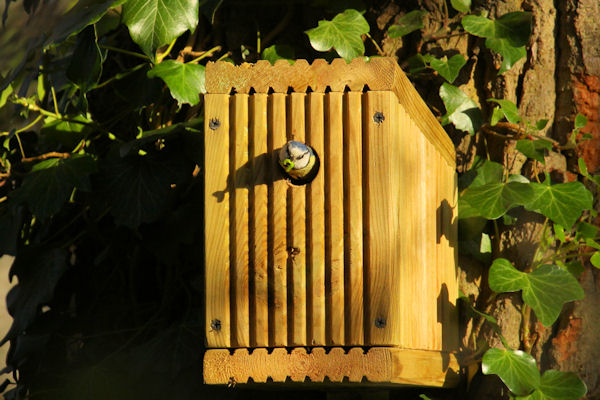Back in 2021 during our first spring as stewards of Bicknor Wood, we experienced nature red in tooth and claw as the Great Spotted Woodpeckers broke into the nest boxes. They took the young chicks from the boxes to feed their own. Squirrels also damaged the boxes. They will eat eggs, chicks and fledglings. The damage so far this year has been done by squirrels. Their teeth continue to grow throughout their life, so they need to chew on stuff to file them down a bit.
The hole in a bird box gives good purchase and the squirrels appear to find them very chewable. If you have sponsored bird boxes 9 or 28, rest assured that they have been repaired and replaced.
Birds have already begun inspecting potential nesting sites. Boxes 7 and 17 have caught the eye of these Blue Tits.
Others still prefer the natural alternatives that present themselves in an old oak tree.

A very approachable Robin has been posing for pictures close to the burnt oak.
It may be one that allowed such close proximity as a chick last year. It would be nice to think so.
Sighting of the month came in the shape of a cock Pheasant. They used to be common before the houses went up and were frequent visitors to the local gardens. Sadly their feeding opportunities have been greatly reduced and it was a surprise to find one settling down to roost on the southern edge of the wood.
Goldcrests are always a delight to watch as they feed restlessly through the branches.
At last, I managed to get a shot of the Chaffinch. This one is a male as shown by his bright colours. The female is drab brown with lighter markings. Not dissimilar to a female House Sparrow.
Oak trees have a close association with all kinds of other life forms in a British woodland. There are fungi and insects which have developed relationships with the oaks over millions of years. At each stage of an oak's life, a different insect will find food, shelter and breeding opportunities. Fungi wait their turn for a seat at the table as the oak passes through its life over hundreds of years.
As standing dead wood, it is invaluable as a habitat resource. The committee had to take the difficult decision to keep the tree safe by trimming back some of the heavy boughs that could have caused a danger to passersby.
But, fear not, the trimmed deadwood, now stacked on the ground will continue to provide habitat for creatures who were not previously able to access it all the way up there. Just another stage in the life of an oak tree with new relationships to be made.
A few chestnut trees were also felled during the safety cut. They are not indigenous to Britain and have not built the same associations and relationships as oak trees. Their timber will not be as highly prized by the environment, but it does make for a good path edging.
There have been fewer Blackbirds this winter compared with previous years. The population in the UK is usually bolstered by European birds trying to escape the worst of a continental winter. Perhaps it has been milder there this winter? Numbers reaching to 18 individuals were recorded during 2020 and 2021, whilst the highest tally this year has been just 8.

















Comments
Post a Comment